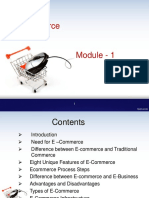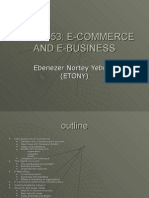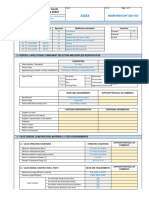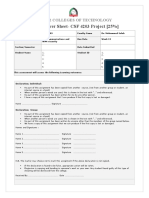0 ratings0% found this document useful (0 votes)
22 viewsE Com
E Com
Uploaded by
monika khannaElectronic commerce involves performing commercial operations electronically through the use of information technology. The entire buying and selling process is completed electronically, from initial contact between buyers and sellers to any subsequent transactions. It uses electronic communications like the internet, email, databases and mobile phones to distribute, market, buy, sell and service products and services.
Copyright:
Attribution Non-Commercial (BY-NC)
Available Formats
Download as PPT, PDF, TXT or read online from Scribd
E Com
E Com
Uploaded by
monika khanna0 ratings0% found this document useful (0 votes)
22 views21 pagesElectronic commerce involves performing commercial operations electronically through the use of information technology. The entire buying and selling process is completed electronically, from initial contact between buyers and sellers to any subsequent transactions. It uses electronic communications like the internet, email, databases and mobile phones to distribute, market, buy, sell and service products and services.
Original Title
e com
Copyright
© Attribution Non-Commercial (BY-NC)
Available Formats
PPT, PDF, TXT or read online from Scribd
Share this document
Did you find this document useful?
Is this content inappropriate?
Electronic commerce involves performing commercial operations electronically through the use of information technology. The entire buying and selling process is completed electronically, from initial contact between buyers and sellers to any subsequent transactions. It uses electronic communications like the internet, email, databases and mobile phones to distribute, market, buy, sell and service products and services.
Copyright:
Attribution Non-Commercial (BY-NC)
Available Formats
Download as PPT, PDF, TXT or read online from Scribd
Download as ppt, pdf, or txt
0 ratings0% found this document useful (0 votes)
22 views21 pagesE Com
E Com
Uploaded by
monika khannaElectronic commerce involves performing commercial operations electronically through the use of information technology. The entire buying and selling process is completed electronically, from initial contact between buyers and sellers to any subsequent transactions. It uses electronic communications like the internet, email, databases and mobile phones to distribute, market, buy, sell and service products and services.
Copyright:
Attribution Non-Commercial (BY-NC)
Available Formats
Download as PPT, PDF, TXT or read online from Scribd
Download as ppt, pdf, or txt
You are on page 1of 21
ELECTRONIC COMMERCE
•This involves performing commercial operations electronically.
•In a usual commercial operation ,buyers and sellers come in contact
with each other either physically or through other means of
communication and rest of the buying/selling procedure is performed in
physical sense.
•However in e-commerce the entire process, including the contact
between buyers and sellers, is completed through the use of IT .
• It consists primarily of the distributing, buying, selling, marketing,
and servicing of products or services over electronic systems such
as internet or other computer networks
• It can involve in electronic funds transfer, supply chain
management, e-marketing, online marketing, online transaction
processing, electronic data interchange, inventory management
systems, and automated data collection system
• It typically uses electronic communications technology such as the
internet, extranet, e-mail, e-books, database, catalogues and mobile
phones
Historic development
• The meaning of the term “electronic commerce” has changed over
the last 30 years.
• Originally electronic commerce meant the facilitation of commercial
transactions electronically, usually using technology like EDI, and
EFT.
• The “electronic” or “e” in e-commerce or e-business refers to the
technology or systems, the commerce refers to be traditional
business models.
• It is defined as the complete set of processes that support
commercial/business activities on a network.
• In 1970’s and 80’s this would have involved information analysis.
• The growth of acceptance of credit cards, ATM’s, telephone banking
were also part of e- commerce
• However from 1990’s this would include enterprise resource
planning (ERP), data mining and data warehousing.
• The first US government electronic commerce system was developed
in 1983 by John Fonda, F.Gordon, Gary Heiselberg
• This system , known as Automation of Procurement and Accounting
Data Entry (APADE) and included the purchase of goods and services
• Today, it encompasses a very wide range of business activities and
processes from e-banking to off-shore manufacturing to e-logistics
• E-Commerce refers to all the forms of transactions related to
commercial activities, including both organizations and individuals,
that are based upon the processing and transmission of digitized
data, including text, sound, and visual images.
• E-Commerce is about doing business electronically. It is based on
the electronic processing and transmission of data , including text,
sound and video. It encompasses diverse activities including
electronic fund transfers, electronic share trading, commercial
auctions etc.
SUCCESS FACTORS IN E-COMMERCE
1. Technical and organizational aspects
– Sufficient work done in market research and analysis
– A good management team armed with good and sound IT strategy.
– Providing an easy and secured way for customers to effect
transactions
– Providing reliability and security
– Constructing a commercially sound business model
– Engineering an electronic value chain
– Setting up an organization of sufficient alertness
– Providing an attractive website
– Streamlining business processes
– Providing complete understanding of the products or services offered
2. Customer-oriented
– Providing value to customers
– Providing service and performance
– Providing an incentive
– Providing personal attention
– Providing a sense of community
– Owning the customers total experience
– Letting customers help themselves
– Helping customers do their job of consuming
3. Acceptance
– Concerns about security
– Lack of instant gratification
– The problem of access to web commerce
– Social aspect of shopping
– Poorly designed websites
– Inconsistent return policies
Features of electronic commerce
1. UBIQUITY: it is available just about everywhere at all times
• This reduces transaction costs-the cost of participating in a
market
2. GLOBAL REACH:
3. UNIVERSAL STANDARDS
4. INTERACTIVITY
5. INFORMATION DENSITY AND RICHNESS
6. PERSONALIZATION
Limitations/failures of e-commerce
• Failure to understand customers, why they buy and how they buy
• Failure to consider the competitive situation
• Inability to predict environmental reaction
• Over-estimation of resource competence
• Failure to coordinate
• Failure to obtain senior management commitment
• Failure to obtain employee commitment
• Under-estimation of time requirements
• Failure to follow a plan
• Becoming the victim of organized crime
E-Commerce applications
1. Business to business(B2B)
2. Business to consumer(B2C)
3. Business to government(B2G)
4. Consumer to administration(C2A)
5. Consumer to Consumer (C2C)
6. Mobile commerce
Business to Business(B2B)
• It involves electronic transactions for business activity between two or more
business organization
• It deals with relationships between and among businesses
• This type of e-commerce model is becoming increasingly important as most
business organizations are reengineering their business processes in which
other organizations may play a vital role.
• B2B enables business partners to exchange information among themselves in
an automated way without the human intervention
• B2B has two primary components
1. E-frastructure
2. E-markets
1. E-frastructure : is the architecture of B2B ,primarily consisting of:
• Logistics
• Ware housing and distribution
• Outsourcing of functions in the process of e-commerce
• Auction solution software for the operation and maintenance of
real-time auctions in the internet
• Content management software for the facilitation of web site
content management and delivery
• Web-based commerce enablers
2. E-markets : these are simply defined as websites where buyers
and sellers interact with each other and conduct transactions.
• Most B2B applications are in the areas of supplier management,
inventory management, distribution management, channel
management and payment management.
• The impact of B2B markets on the economy of developing countries
is evident in the following:
• Transaction costs
• Disintermediation
• Economies of scale and network effects
Business to consumer(B2C)
• Is commerce between companies and consumers, involves customers
gathering information ,purchasing physical goods or information goods,
receiving products over an electric network.
• Involves bringing business and consumers closer to each other and creating
a unique market place where products and services can be bought and
sold.
• It is conducted by providing well-designed websites which offer information
about products/services to be sold, display these with description, price in
the same manner as conventional shops do.
• It not only provide source of trade but also acts as supporting activities that
that help to generate revenue to companies.
• Examples are shopping sites, home banking, entertainment services- video
on demand, movies, games etc
• The most common applications of this type of e-commerce are in the areas
of purchasing products and information, and personal finance management,
which pertains to the management of personal investments and finances
with the use of online banking tools.
Business to government(B2G)
• Involves dealing with government agencies like customs, excise
duties etc, electronically
• Usually a lot of paper work is involved resulting into delay in paper
processing which hampers efficiency of business organizations.
• Instead of this lengthy and time consuming paper work , B2G e-
commerce application connects various government agencies and
business organizations electronically which helps in speedy
processing of business documents thereby enhancing productivity
of business organizations.
Consumer to administration(C2A)
• It involves providing relevant information to people by government
administrative agencies.
• Instead of visiting government offices for getting relevant
information, people can get this information through C2A websites.
Consumer to Consumer (C2C)
• Is simply commerce between private individual or consumers
• This type of e-commerce is characterized by the growth o
electronic marketplaces and online auctions, particularly in
vertical industries where firms /businesses can bid for what they
want from among multiple suppliers.
• It has the greatest potential for developing new markets.
• this type of e-commerce comes in at least three forms:
1. Auctions
2. Peer-to-peer systems
3. Classified ads
Mobile commerce
• Mobile commerce is the buying and selling of goods and services
through wireless technology i.e- handheld devices such as
cellular telephones and personal digital assistants.
• Industries affected by M-commerce include the following:
1. Financial services
2. Telecommunications
3. Information services
Electronic commerce/ Electronic business
• Electronic commerce is a business to business (B2B) initiative
aimed at communicating business transaction documents on a real
time or near real time basis between known trading partners, such
as suppliers, customers, and increasingly between customers
customer and suppliers and supplier
• Use of electronic representations of business transactions
documents can reduce processing and handling , thereby reducing
processing costs, data entry errors and cycle times.
• Electronic business represents the internet based marketing
channel that has emerged, first slowly and then explosively
• It is aimed at selling products or services via internet
• Electronic business initiatives often provide both pre sales and post
sales support, directly to consumers on a self service basis.
How do e-commerce link customers, workers, suppliers,
distributors and competitors
• E-commerce facilitates organization networks , wherein small firms depend
on partner firms for supplies and product distribution to address customer
demands more effectively.
• To maintain the chain of networks linking customers , an integrated or
extended supply chain management solution is needed.
• Supply chain management is defined as the supervision of materials,
information, and finances as they move from supplier to manufacturer to
wholesaler to retailer to customer.
• It involves the coordination and integration of these flows both within and
among companies.
• The goal of any SCM system is timely provision of goods or services to the
next link in the chain.
• The three main flows in the SCM are
– The product flow
– The information flow
– The finances flow
You might also like
- E-Commerce and E-Commerce ApplicationsDocument51 pagesE-Commerce and E-Commerce Applicationsgatete samNo ratings yet
- Nina Simone Love Me or Leave Me 2Document9 pagesNina Simone Love Me or Leave Me 2xxx0% (5)
- M Unit-2Document46 pagesM Unit-2Dr. Vinod KumarNo ratings yet
- E Commerce ISADocument162 pagesE Commerce ISAnitunjaychauhanNo ratings yet
- Introduction To E-CommerceDocument30 pagesIntroduction To E-CommerceSuraj ShahNo ratings yet
- E CommerceDocument44 pagesE CommercezindabotNo ratings yet
- The Nature of Electronic Commerce Group 2Document23 pagesThe Nature of Electronic Commerce Group 2Danica ZabalaNo ratings yet
- Unit 1 - Introduction To E-Commerce - BCADocument37 pagesUnit 1 - Introduction To E-Commerce - BCAbamoked256No ratings yet
- E-Commerce Notes Unit-1 Lecture-1Document21 pagesE-Commerce Notes Unit-1 Lecture-1Pankaj Singh NegiNo ratings yet
- E-Commerce Chapter 1Document25 pagesE-Commerce Chapter 1Abdulaziz Andurasul100% (1)
- Lecture 6 Is in Business E-CommerceDocument21 pagesLecture 6 Is in Business E-Commerceddamuliracharles88No ratings yet
- Lecture 4 E-COMMERCEDocument37 pagesLecture 4 E-COMMERCEgershon004No ratings yet
- E-Commerce: Instructor: Yakub Ahmed YakubDocument33 pagesE-Commerce: Instructor: Yakub Ahmed YakubFaaiso LajecleeyNo ratings yet
- MIT Report Group 10Document9 pagesMIT Report Group 10RoroNo ratings yet
- EBA Chapter 1 - e Business and AccountingDocument13 pagesEBA Chapter 1 - e Business and Accountingjkshree1930No ratings yet
- E CommerceDocument4 pagesE Commerceshriyanshrauthan833No ratings yet
- Electronic Commerce: Gurvinder Singh 500902015Document31 pagesElectronic Commerce: Gurvinder Singh 500902015Swapn DeepNo ratings yet
- Acadmic Script 29200302050503033737Document12 pagesAcadmic Script 29200302050503033737Chirayu SinghNo ratings yet
- Brief Introduction To E-Business ArchitectureDocument57 pagesBrief Introduction To E-Business ArchitectureClement MensahNo ratings yet
- E-Business Management: Session 1 - IntroductionDocument64 pagesE-Business Management: Session 1 - IntroductionRitu RajNo ratings yet
- Introduction To E-CommerceDocument40 pagesIntroduction To E-CommerceSushma NaiduuNo ratings yet
- E-Business and How It Levels The Playing Field: Rodolfo Noel S. QuimboDocument18 pagesE-Business and How It Levels The Playing Field: Rodolfo Noel S. QuimboSuiNo ratings yet
- Chapter 1 e ComerceDocument15 pagesChapter 1 e ComerceMohammed HusenNo ratings yet
- Unit 1 (E Commerce)Document24 pagesUnit 1 (E Commerce)20B81A1235cvr.ac.in G RUSHI BHARGAVNo ratings yet
- Unit 1 e-commerce (electronic commerce)Document161 pagesUnit 1 e-commerce (electronic commerce)arsangeetaNo ratings yet
- E Ommerce NotesDocument37 pagesE Ommerce Notesmarapallyvarunkumar11No ratings yet
- The Nature of Electronic Commerce Group 2Document22 pagesThe Nature of Electronic Commerce Group 2Danica Zabala100% (1)
- The Nature of Electronic Commerce Group 2Document22 pagesThe Nature of Electronic Commerce Group 2Danica ZabalaNo ratings yet
- Introduction To E-CommerceDocument28 pagesIntroduction To E-CommerceFlorence ReyesNo ratings yet
- TBW Individual Report Writing Progect: E-Commerce: ObjectiveDocument13 pagesTBW Individual Report Writing Progect: E-Commerce: ObjectiveShaan CapricornNo ratings yet
- E-Commerces CH 1-4Document59 pagesE-Commerces CH 1-4Ruach Dak TangNo ratings yet
- WEEK 14 - E-CommerceDocument25 pagesWEEK 14 - E-Commerceselwyn.magboo789No ratings yet
- Introduction To E-Business in Food Industry: Ms. B.M.R.L. Basnayake Department of Agribusiness ManagementDocument29 pagesIntroduction To E-Business in Food Industry: Ms. B.M.R.L. Basnayake Department of Agribusiness Managementjmbn bandaraNo ratings yet
- E CommerceDocument15 pagesE Commerceendashaw debruNo ratings yet
- E CommerceDocument109 pagesE CommerceAkhil Mathew PhilipNo ratings yet
- Ecommerce Notes Unit-1Document54 pagesEcommerce Notes Unit-1KajalNo ratings yet
- Unit IDocument29 pagesUnit IPrameela KNo ratings yet
- 1083 - UNIT-1 E-CommerceDocument10 pages1083 - UNIT-1 E-Commerce21.094akhilaNo ratings yet
- ECommerce 4 TH SemDocument11 pagesECommerce 4 TH Semkavya GowdaNo ratings yet
- By Mr. Dhanush LeelodharryDocument25 pagesBy Mr. Dhanush Leelodharryabhishek kumar bhaugeeruthyNo ratings yet
- Unit VDocument21 pagesUnit Vlal213090No ratings yet
- Unit 1Document28 pagesUnit 1Jany TolaniNo ratings yet
- E CommerceDocument19 pagesE CommerceA I M E NNo ratings yet
- bba106Document81 pagesbba106Tanish LalwaniNo ratings yet
- E-Commerce and Its Business ModelDocument95 pagesE-Commerce and Its Business Modeleyedol97% (67)
- Ecommerce Course Material For Mid Term ExamDocument25 pagesEcommerce Course Material For Mid Term ExamDaniyal BhatNo ratings yet
- E CommerceDocument19 pagesE CommerceNikita agarwalNo ratings yet
- Unit 1Document127 pagesUnit 1nipurnjain87No ratings yet
- L1 - E-Commerce FrameworkDocument28 pagesL1 - E-Commerce FrameworkShaarveen RajNo ratings yet
- Degree Course (Iii Year) ECOMMERCE Notes: Unit-IDocument30 pagesDegree Course (Iii Year) ECOMMERCE Notes: Unit-IrohitNo ratings yet
- CSC-370 E - Commerce: (BSC Csit, Tu)Document33 pagesCSC-370 E - Commerce: (BSC Csit, Tu)Nezuko KamadoNo ratings yet
- E-commerce_Sessions 1-7Document80 pagesE-commerce_Sessions 1-7bilaalrashid2006No ratings yet
- Ecommerce UnitDocument49 pagesEcommerce UnitmandeepNo ratings yet
- ITE101 Living in The IT Era Week 13Document7 pagesITE101 Living in The IT Era Week 13P MarieNo ratings yet
- (COMPUTERS) DEGREE COURSE (III YEAR) E-COMMERCE - nOTESDocument36 pages(COMPUTERS) DEGREE COURSE (III YEAR) E-COMMERCE - nOTESKingpinNo ratings yet
- Ecommerce Unit - 1 E-Commerce Notes Unit-1 Lecture-1Document52 pagesEcommerce Unit - 1 E-Commerce Notes Unit-1 Lecture-1AJNo ratings yet
- E Commerce Lecture1Document25 pagesE Commerce Lecture1feda jahjahNo ratings yet
- Code 386 RepairDocument12 pagesCode 386 RepairCarlos A RomeroNo ratings yet
- Unit 1 Introduction To Computers, Algorithms & CDocument73 pagesUnit 1 Introduction To Computers, Algorithms & C16v.harshiniNo ratings yet
- ASME Y14.45 - Draft - Public - ReviewDocument97 pagesASME Y14.45 - Draft - Public - ReviewDOR ESHELNo ratings yet
- LifiDocument31 pagesLifiHarsha VardhanNo ratings yet
- Neom Nwa Dat 2021 021 Air ValveDocument5 pagesNeom Nwa Dat 2021 021 Air ValveES RAANo ratings yet
- The Implementation of World Class Manufacturing Techniques in Egyptian Manufacturing Firms An Empirical StudyDocument16 pagesThe Implementation of World Class Manufacturing Techniques in Egyptian Manufacturing Firms An Empirical StudybojanbijNo ratings yet
- Strike Guard WAVE OverviewDocument12 pagesStrike Guard WAVE OverviewMohamad HishamNo ratings yet
- Distribution Network Types and Configurations: 1.1 Power System StructureDocument18 pagesDistribution Network Types and Configurations: 1.1 Power System StructureMohammed FaggalNo ratings yet
- Name: Purushotham E-Mail: Purushothamthota635 Gmail Com Phone:+91-9705725472 Summary of ExperienceDocument3 pagesName: Purushotham E-Mail: Purushothamthota635 Gmail Com Phone:+91-9705725472 Summary of ExperiencepurushothamNo ratings yet
- Solid Principles SuccinctlyDocument78 pagesSolid Principles Succinctlyjeidison fariasNo ratings yet
- Indian Institute of Technology KHARAGPUR - 721302: WWW - Iitkgp.ac - inDocument22 pagesIndian Institute of Technology KHARAGPUR - 721302: WWW - Iitkgp.ac - inHarikrishnan M KNo ratings yet
- Presentation 1Document47 pagesPresentation 1Muhammad Ihsan ToorNo ratings yet
- Ayman Salah: Civil EngineerDocument2 pagesAyman Salah: Civil EngineerMostafa IsmailNo ratings yet
- Good Used Caterpillar D398 850HP EngineDocument2 pagesGood Used Caterpillar D398 850HP EngineMahgdis EsaNo ratings yet
- Database Programming With SQL Mid Semester 1Document54 pagesDatabase Programming With SQL Mid Semester 1José Obeniel LópezNo ratings yet
- High Rise Structural System-Bundled Tube System: Applying LoadsDocument2 pagesHigh Rise Structural System-Bundled Tube System: Applying Loadsekta kachhelaNo ratings yet
- 202441389046BF SalisuDocument1 page202441389046BF Salisuusmansalis101No ratings yet
- Introduction To Computer Networks Exampl PDFDocument8 pagesIntroduction To Computer Networks Exampl PDFfreedom mutepfeNo ratings yet
- Peterborough Regional Health Centre Virtual Visiting ProgramDocument1 pagePeterborough Regional Health Centre Virtual Visiting ProgramPeterborough ExaminerNo ratings yet
- User's Manual: Model BARD Safety BarriersDocument10 pagesUser's Manual: Model BARD Safety Barriersrizky ListyawanNo ratings yet
- V.S.B. Engineering College, Karur Department of MechanicalDocument2 pagesV.S.B. Engineering College, Karur Department of MechanicalsakthisparcoNo ratings yet
- New Balance PaceIQ Wireless ManualDocument22 pagesNew Balance PaceIQ Wireless Manualbeautiful_disasterx3No ratings yet
- Project Cover Sheet-CSF 4203 Project (25%) : Higher Colleges of TechnologyDocument8 pagesProject Cover Sheet-CSF 4203 Project (25%) : Higher Colleges of TechnologyengrrhasanNo ratings yet
- Nivas Resume For SIPDocument2 pagesNivas Resume For SIPnivas.sNo ratings yet
- Deloitte Pyspark Interview Questions for Data Engineer 2024 _ by Ronit Malhotra _ Jun, 2024 _ MediumDocument9 pagesDeloitte Pyspark Interview Questions for Data Engineer 2024 _ by Ronit Malhotra _ Jun, 2024 _ MediumManoj PandeyNo ratings yet
- 205-03 Front Drive Axle and Differential - Removal and Installation - Axle Carrier BushingDocument7 pages205-03 Front Drive Axle and Differential - Removal and Installation - Axle Carrier BushingCARLOS LIMADANo ratings yet
- BOOK - Engineering Graphics & Design - 8 Sept Final 230 PMDocument236 pagesBOOK - Engineering Graphics & Design - 8 Sept Final 230 PMmadhukeshwaraNo ratings yet
- Dimensional Analysis and Acheivable Tolerance in Die CastingDocument50 pagesDimensional Analysis and Acheivable Tolerance in Die CastingM PraveenNo ratings yet
- Error CodesDocument64 pagesError CodesVikNo ratings yet

























































































